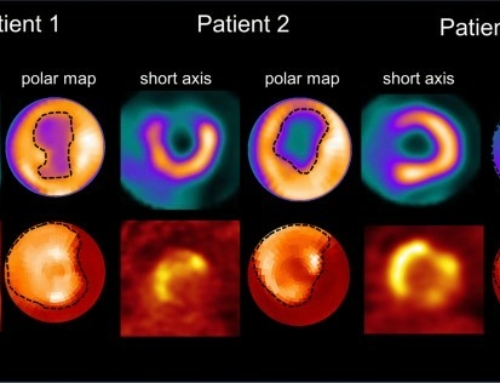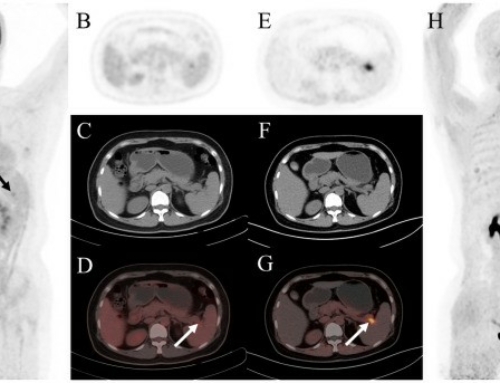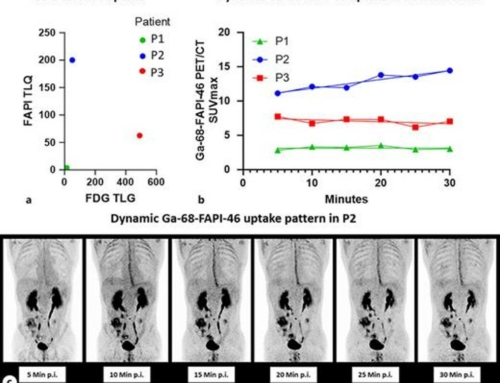Ling Chen, Shan Zheng, Linying Chen, Sunwang Xu, Kunlin Wu, Lingjun Kong, Jiajie Xue, Xiangjin Chen, Weibing Miao, Youzhi Zhu
Abstract
68Ga-labeled fibroblast activation protein inhibitor (68Ga-FAPI) PET/CT has demonstrated promising clinical results, with a higher SUVmax and tumor-to-background ratio (TBR) in breast cancer (BC) patients than 18F-FDG PET/CT. Here, we aimed to evaluate the suitability of 68Ga-FAPI PET/CT for the early and late prediction of the pathologic response to neoadjuvant chemotherapy (NAC) in BC.
Methods
Twenty-two consecutive patients with newly diagnosed BC and an indication for NAC were prospectively included. All patients underwent standard chemotherapy and 68Ga-FAPI PET/CT at baseline, after 2 cycles of NAC (PET2), and 1 wk before surgery (PET3). SUVmax was measured in the primary tumor region and positive regional lymph nodes. The expression of fibroblast activation protein in the primary lesion was analyzed by immunohistochemistry.
Results
Seven patients (31.8%) achieved a pathologic complete response (pCR), and 15 (68.2%) had residual tumors. Thirteen patients (59.1%) showed concentric withdrawal of the primary tumor, and 9 (40.9%) showed diffuse withdrawal. Between PET2 and PET3, the ΔSUVmax of the primary tumor (R 2 = 0.822; P = 0.001) and metastatic lymph nodes (R 2= 0.645; P = 0.002) were significantly correlated. The absolute values of SUVmax and TBR at PET2 and PET3 were lower in patients with pCR than in those without pCR (P < 0.05). Moreover, a larger ΔSUVmax at any time point was strongly associated with pCR (P < 0.05). Similar downward trends in SUVmax, TBR, and ΔSUVmax were observed in the pattern of primary tumor reduction. For predicting pCR, the optimal cutoff values for ΔSUVmax after 2 chemotherapy cycles, ΔSUVmaxbefore surgery, TBR after 2 chemotherapy cycles, and TBR before surgery of the primary tumor were 3.4 (area under the curve [AUC], 0.890), 1.1 (AUC, 0.978), -63.8% (AUC, 0.879), -90.8% (AUC, 0.978), 7.6 (AUC, 0.848), and 1.4 (AUC, 0.971), respectively. Immunohistochemistry showed that the SUVmax and TBR of 68Ga-FAPI PET/CT were positively correlated with fibroblast activation protein expression (P < 0.001 for both).
Conclusion
Assessment of early changes in 68Ga-FAPI uptake during NAC by 68Ga-FAPI PET/CT can predict pCR and primary tumor concentric withdrawal in BC patients. 68Ga-FAPI PET/CT has great potential for the early and late prediction of the pathologic response to NAC in BC.


![Efficacy of [68Ga]Ga-FAPI-PET as a non-invasive evaluation method of liver fibrosis](https://sofie.com/wp-content/uploads/2025/06/info.ibamolecular-500x383.png)
![Comparison of [99mTc]Tc-FAPI SPECT/CT and [18F]FDG PET/CT as predictive biomarkers for immunotherapy response in gastrointestinal cancer](https://sofie.com/wp-content/uploads/2025/06/info.ibamolecular-500x383.jpg)


